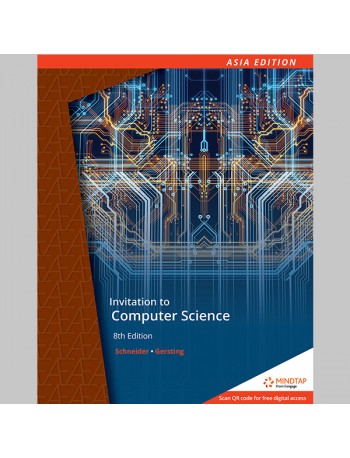
- Stock: Out Of Stock
- Weight: 0.85kg
- ISBN: 9789814834636
Offer a contemporary overview of computer science with Schneider/Gersting's best-selling INVITATION TO COMPUTER SCIENCE, 8E. This flexible, non-language-specific text uses an algorithm-centered approach to provide a foundation in computing. Learning objectives and a clear hierarchy help introduce algorithms, hardware, virtual machines, software development, applications of computing, and social issues. Updated exercises and practice problems challenge students to analyze, evaluate, and approach problems creatively. Special interest boxes and timely content highlight topics such as privacy, drones, cloud computing, and net neutrality. Optional online modules for C++, Java, Python, C#, and Ada integrate seamlessly for the flexibility to teach a specific programming language. Optional MindTap® provides study tools and a digital Lab Manual and lab software with 20 laboratory projects.
Features
- ACTIONABLE AND MEASURABLE LEARNING OBJECTIVES LEAD STUDENTS IN MASTERING IMPORTANT CONCEPTS.
- SOLID OVERVIEW PRESENTS BREADTH OF COMPUTER SCIENCE WITHOUT PROGRAMMING LANGUAGE SPECIFICS.
- UNIQUE APPROACH INTEGRATES TOPICS USING THE CONCEPT OF ALGORITHMS.
- EXTENSIVE EXERCISES AND PROBLEMS PROVIDE NUMEROUS OPPORTUNITIES FOR CONCEPT APPLICATION.
- SPECIAL INTEREST BOXES HIGHLIGHT THE LATEST AND TECHNOLOGY AS WELL AS HISTORIC BACKGROUND.
- OPTION TO INTEGRATE PROGRAMMING LANGUAGES OFFERS ULTIMATE FLEXIBILITY.
- LAB SOFTWARE AND LAB EXERCISES WORK SEAMLESSLY WITH THE TEXT.
Table of Contents
1. An Introduction to Computer Science.
Part I: THE ALGORITHMIC FOUNDATIONS OF COMPUTER SCIENCE.
2. Algorithm Discovery and Design.
3. The Efficiency of Algorithms.
Part II: THE HARDWARE WORLD.
4. The Building Blocks: Binary Numbers, Boolean Logic, and Gates.
5. Computer Systems Organization.
Part III: THE VIRTUAL MACHINE.
6. An Introduction to System Software and Virtual Machines.
7. Computer Networks and Cloud Computing.
8. Information Security.
Part IV: THE SOFTWARE WORLD.
9. Introduction to High-Level Language Programming.
10. The Tower of Babel.
11. Compilers and Language Translation.
12. Models of Computation.
Part V: APPLICATIONS.
13. Simulation and Modeling.
14. Electronic Commerce, Databases, and Personal Privacy
15. Artificial Intelligence.
16. Computer Graphics and Entertainment: Movies, Games, and Virtual Communities.
Part VI: SOCIAL ISSUES IN COMPUTING.
17. Making Decisions about Computers, Information, and Society.
